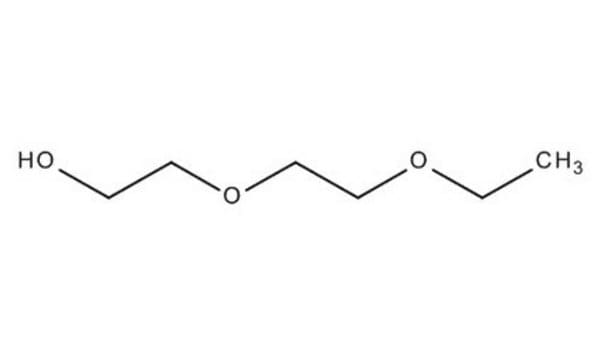8.02933
Diethylenglycoldibutylether
for synthesis
Synonym(e):
Diethylenglycoldibutylether
About This Item
Empfohlene Produkte
Dampfdruck
0.01 hPa ( 20 °C)
Qualitätsniveau
Assay
≥98.0% (GC)
Form
liquid
Selbstzündungstemp.
268 °C
Wirksamkeit
3900 mg/kg LD50, oral (Rat)
3555 mg/kg LD50, skin (Rabbit)
bp
254 °C/1013 hPa
mp (Schmelzpunkt)
-60 °C
Übergangstemp.
flash point 118 °C
Löslichkeit
3 g/L
Dichte
0.88 g/cm3 at 20 °C
Lagertemp.
2-30°C
InChI
1S/C12H26O3/c1-3-5-7-13-9-11-15-12-10-14-8-6-4-2/h3-12H2,1-2H3
InChIKey
KZVBBTZJMSWGTK-UHFFFAOYSA-N
Anwendung
- Transport and Association of Ions in Lithium Battery Electrolytes Based on Glycol Ether Mixed with Halogen-Free Orthoborate Ionic Liquid: This study explores the solvent properties of glycol ethers, including diethylene glycol dibutyl ether, in enhancing the performance of lithium battery electrolytes. The findings suggest that these solvents facilitate superior ionic mobility, potentially improving battery efficiency and safety (Shah FU, et al., 2017).
- Glymes as new solvents for lipase activation and biodiesel preparation: Diethylene glycol dibutyl ether is highlighted as an effective solvent for lipase activation, which is crucial in biodiesel production. This application demonstrates the solvent′s potential in biofuel technologies, enhancing enzyme activity and stability (Tang S, et al., 2013).
- Extraction and carrier-facilitated transport of amino acids using synthetic non-cyclic receptors through bulk liquid membrane: This research indicates the utility of diethylene glycol dibutyl ether in the selective transport and extraction of amino acids across synthetic membranes, offering insights into its applications in biotechnological and pharmaceutical industries (Joshi P, et al., 2006).
Hinweis zur Analyse
Dichte (d 20 °C/ 4 °C): 0,882–0,884
Peroxid (als H₂O₂): ≤ 0,005 %
Identität (IR): entspricht
Lagerklassenschlüssel
10 - Combustible liquids
WGK
WGK 1
Flammpunkt (°F)
244.4 °F - closed cup
Flammpunkt (°C)
118 °C - closed cup
Analysenzertifikate (COA)
Suchen Sie nach Analysenzertifikate (COA), indem Sie die Lot-/Chargennummer des Produkts eingeben. Lot- und Chargennummern sind auf dem Produktetikett hinter den Wörtern ‘Lot’ oder ‘Batch’ (Lot oder Charge) zu finden.
Besitzen Sie dieses Produkt bereits?
In der Dokumentenbibliothek finden Sie die Dokumentation zu den Produkten, die Sie kürzlich erworben haben.
Unser Team von Wissenschaftlern verfügt über Erfahrung in allen Forschungsbereichen einschließlich Life Science, Materialwissenschaften, chemischer Synthese, Chromatographie, Analytik und vielen mehr..
Setzen Sie sich mit dem technischen Dienst in Verbindung.







